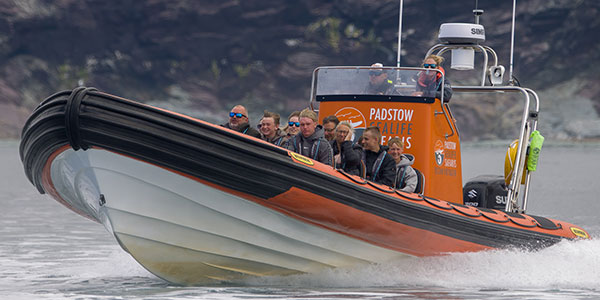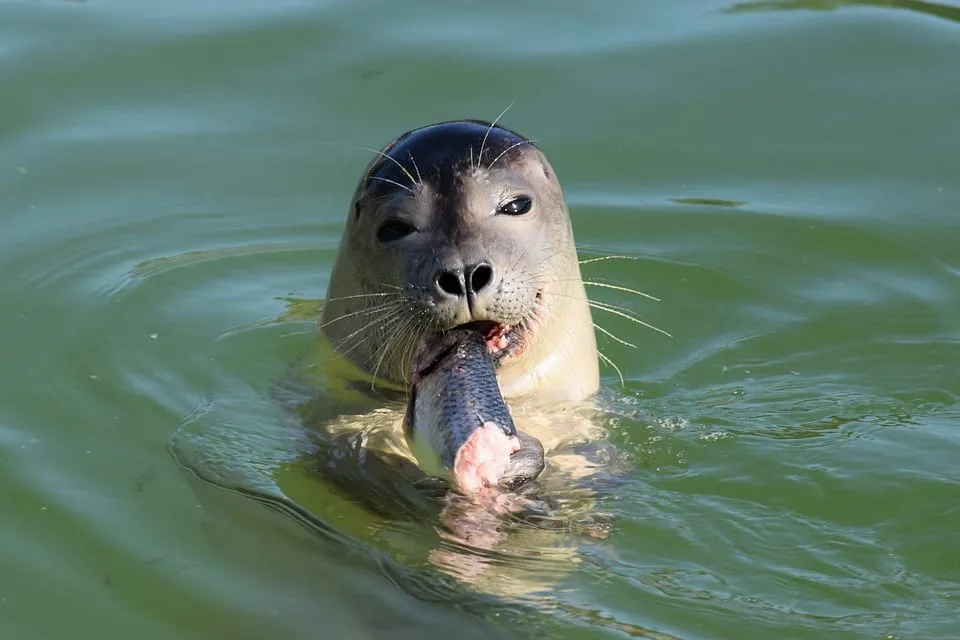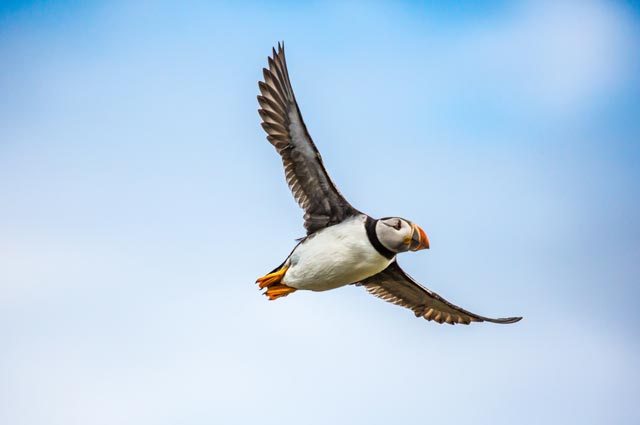Cornwall’s coastline, known for its breathtaking beauty, is also home to an array of magnificent birds of prey. This guide delves into the fascinating world of these avian predators, exploring their unique habitats, behaviour, and the best spots for birdwatching. It also covers crucial conservation efforts and tips for observing these majestic creatures.
Discovering Cornwall’s Birds of Prey
Cornwall’s varied coastlines and diverse habitats are a haven for a variety of birds of prey, each with their own unique characteristics and behaviours. From the swift and agile Peregrine Falcon, known for its high-speed dives, to the Buzzard with its broad wings and leisurely flight, these birds are a testament to the richness of Cornwall’s natural environment.
The Kestrel, often seen hovering over fields, and the rare and elusive Red Kite, hidden in woodland areas, add to the diversity. Observing these birds provides a glimpse into the complex ecosystem of the region and the intricate balance of nature. Cornwall’s birds of prey not only contribute to the ecological balance but also offer an enchanting experience for birdwatchers and nature lovers.
Kestrel
The Kestrel, a familiar sight in Cornwall, is easily recognised by its ability to hover in the air with rapid, fluttering wing beats. These small raptors have a distinctive plumage, with males displaying grey heads and tails and females showing a more brownish tone.
Kestrels primarily feed on small mammals and insects, often seen scanning the ground from a high vantage point before swooping down on their prey. Their presence in Cornwall is a testament to the region’s rich and diverse habitats, from open fields to cliff edges.
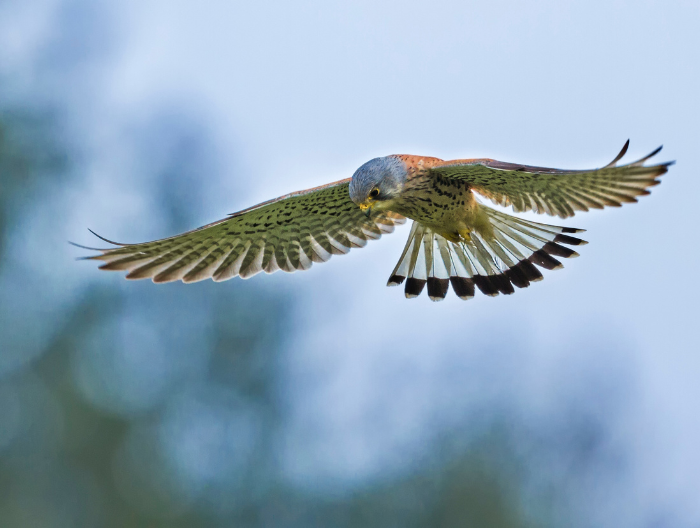
Hobby
The Hobby, a small and agile falcon, is known for its impressive aerial skills, especially during the pursuit of dragonflies and other insects, which it often catches mid-air. This bird is characterised by its slender wings and long tail, which facilitate its acrobatic flight.
Hobbies have a distinct appearance with dark slate-grey upper parts and a rufous underbelly, making them a striking sight against the Cornish skies. They migrate to Cornwall during the summer months, adding a dynamic element to the region’s birdlife.
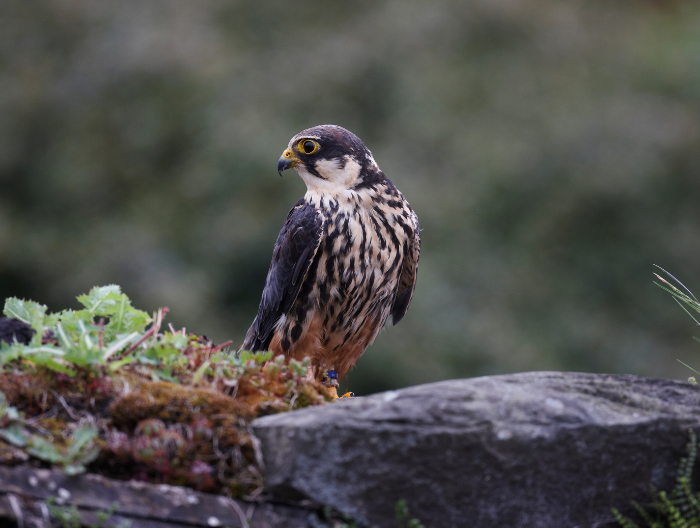
Peregrine Falcon
The Peregrine Falcon, renowned for being the fastest bird in the world, is a spectacular sight in Cornwall. These falcons are characterised by their sleek, streamlined bodies, sharp talons, and distinctive facial markings.
They are known for their high-speed dives, reaching over 200 miles per hour, to catch their prey mid-air. Peregrine Falcons prefer nesting on cliff faces, but can also be found in urban areas, and are admired for their incredible hunting abilities and speed.
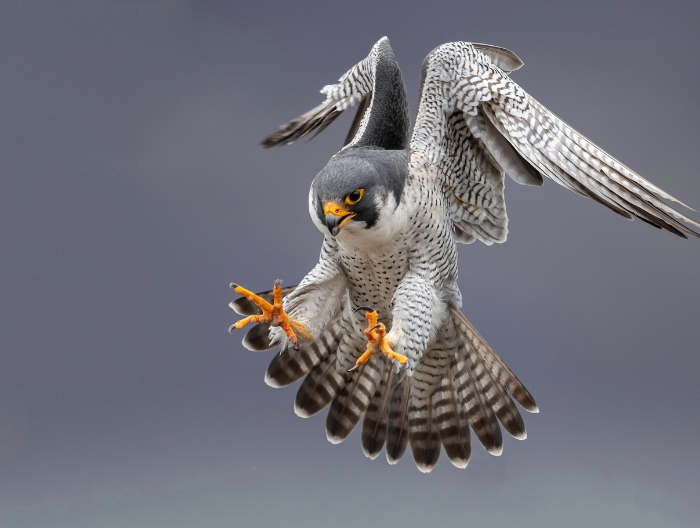
Merlin
The Merlin, a small and swift falcon, is a notable presence in Cornwall. It is smaller than most other falcons, with a compact build and pointed wings ideal for high-speed chases.
The Merlin is known for its fast, low-level flight, often hunting small birds across open countryside. They exhibit beautiful plumage, varying from blue-grey in males to brown in females.
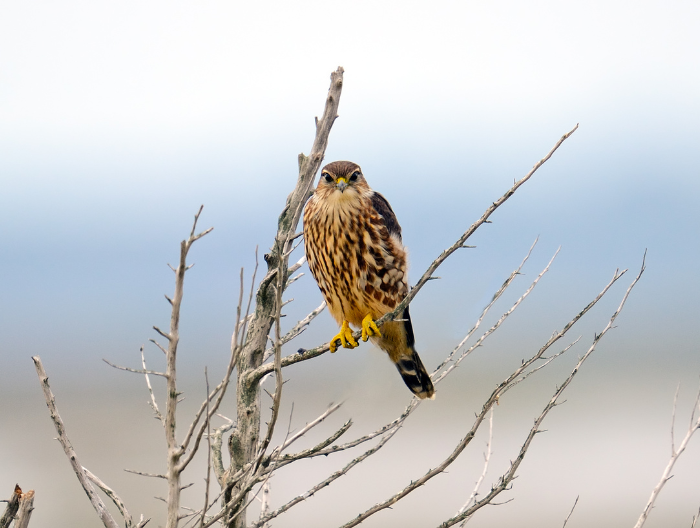
Short-eared owl
The Short-eared Owl, a distinctive bird of prey in Cornwall, is known for its striking appearance, with prominent, ear-like tufts and piercing yellow eyes. It has a relatively large, round head and mottled brown plumage.
The Short-eared owls are often seen hunting during daylight, particularly at dawn and dusk, gliding low over open fields and marshes in search of small mammals while they spend their winters in the county.
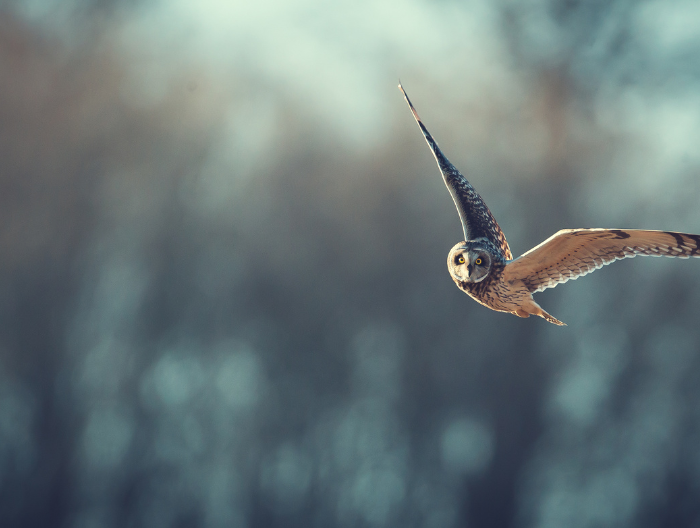
Little owl
The Little Owl, a small bird of prey known for its distinctive appearance and character, is very scare in Cornwall. It has a squat, stocky body, large head, and piercing yellow eyes, with speckled brown and white plumage.
The little owls are often active during the day, which makes them more visible than other owl species. They adapt well to a variety of habitats but prefer open countryside with scattered trees. Their diet consists mainly of insects and small vertebrates.
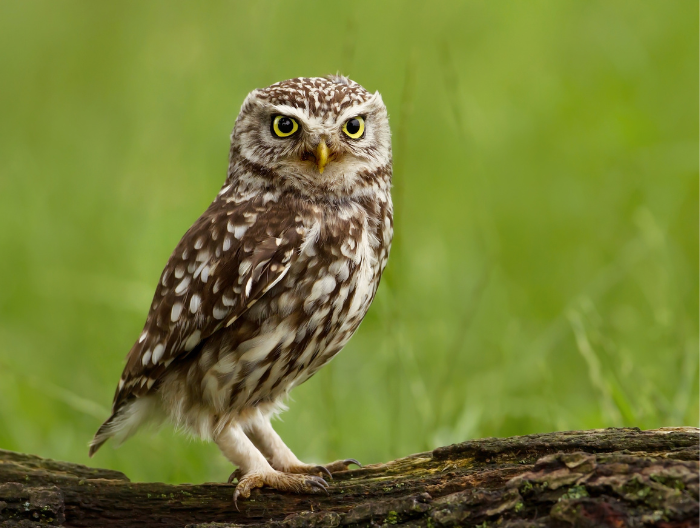
Barn owl
The Barn Owl, a beloved and iconic bird of prey in Cornwall, is recognized for its heart-shaped face, white plumage, and eerie, ghost-like appearance in flight. These owls are primarily nocturnal, hunting in open fields and farmlands for small mammals like voles and mice.
Their silent flight and exceptional hearing make them adept hunters.
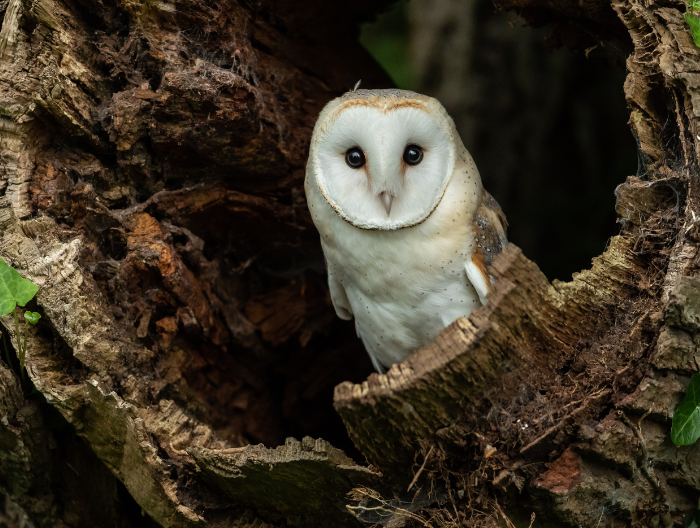
Red kite
The Red Kite, easily identifiable by its reddish-brown body, contrasting black wingtips, and deeply forked tail, is a remarkable bird of prey that has made a significant comeback in the UK, although still rare in Cornwall. Known for its graceful flight and acrobatic displays, the Red Kite primarily feeds on carrion and small mammals.
They are often seen soaring over open countryside and woodlands. The resurgence of the Red Kite population is a conservation success story, and their increasing sightings in Cornwall bring much excitement to local birdwatchers, adding a vibrant touch to the region’s avian diversity.
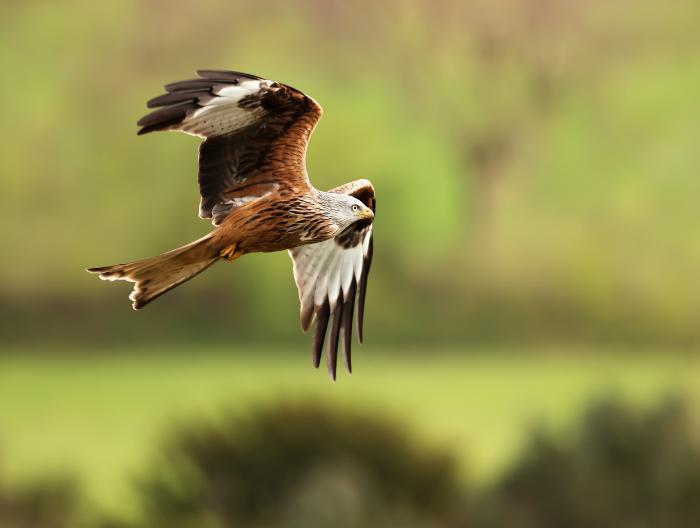
Osprey
The Osprey, a distinctive bird of prey, is known for its diet almost exclusively of fish, making it unique among British raptors.
These birds are large-sized with a white underside, dark brown upper parts, and a characteristic M-shape in flight. Ospreys are often seen hovering over water before diving feet-first to catch fish in the spring and autumn months as they pass through Cornwall on their migration to and from West Africa.
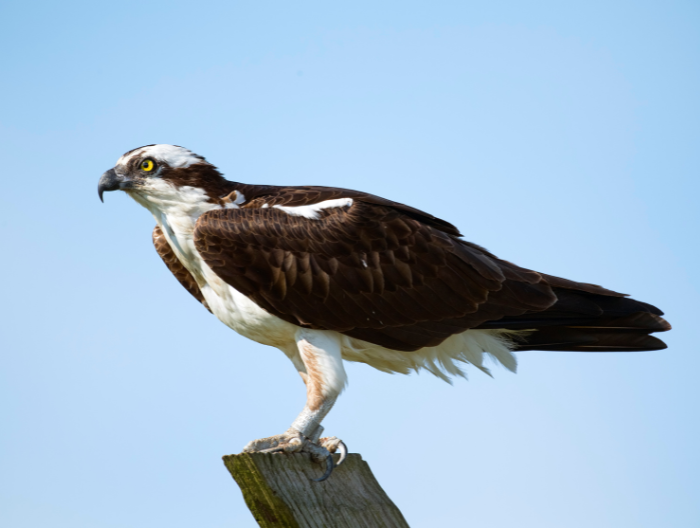
Marsh Harrier
The Marsh Harrier, once a rare sight, has made a remarkable recovery and can now be seen in Cornwall’s wetland areas.
Characterised by its long wings and tail, and a distinctive flight pattern with wings held in a shallow ‘V’, it is known for its agility in the air. The Marsh Harrier’s diet primarily includes small birds and mammals.
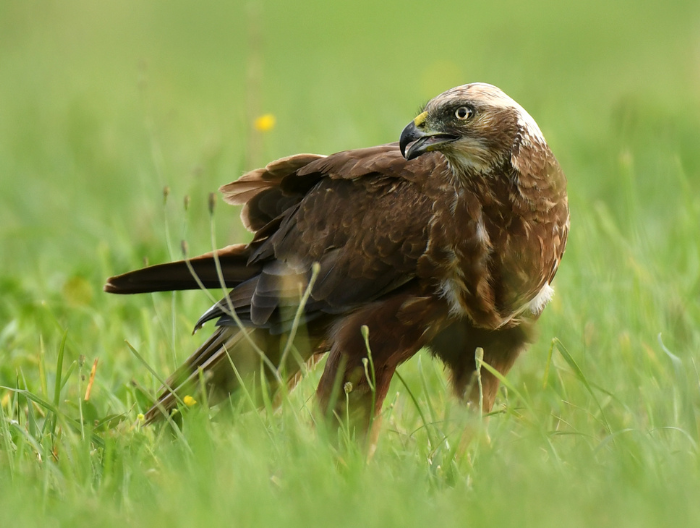
Hen Harrier
The Hen Harrier, a graceful raptor, is known for its distinctive aerial displays and a diet that includes small mammals and birds.
Males have a striking grey plumage with black wingtips, while females are larger, with brown feathers. They breed in heather moorlands but can also be seen in winter in lowland farmland and marshes.
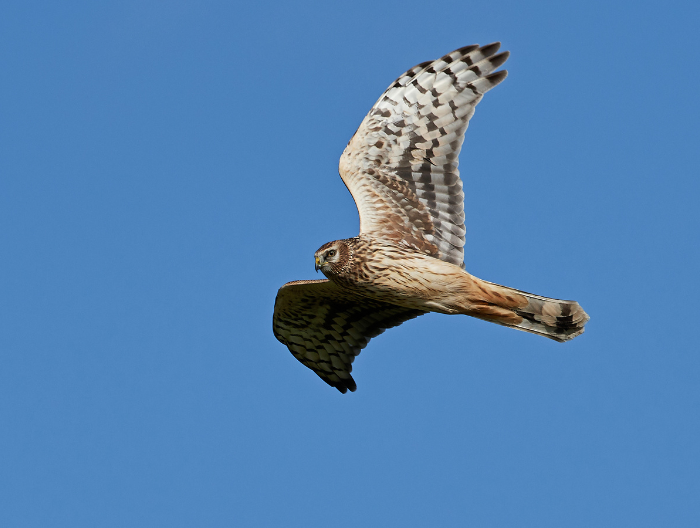
Buzzard
The Buzzard, commonly seen in Cornwall, is a versatile and adaptable bird of prey. It is known for its broad wings and rounded tail, often seen soaring in the sky or perched in trees or even on roadsides.
Buzzards have a varied diet, feeding on small mammals, birds, and carrion. They have a mewing call and are often seen in pairs.
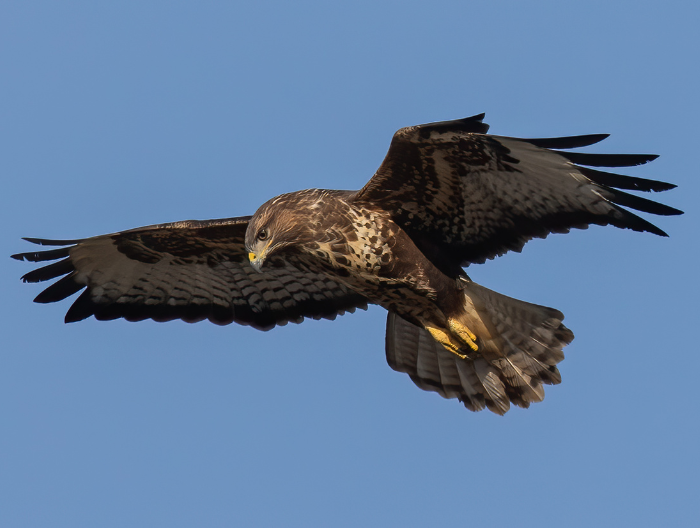
Sparrowhawk
The Sparrowhawk, a small yet formidable bird of prey found in Cornwall, is known for its agile and swift hunting skills in woodland areas. With a compact body, short wings, and long tail, the Sparrowhawk is adept at manoeuvring through dense foliage.
The male has a distinctive slate-grey back and wings, while the female is larger with brown plumage. These birds primarily prey on smaller birds, showcasing remarkable aerial dexterity during the hunt.
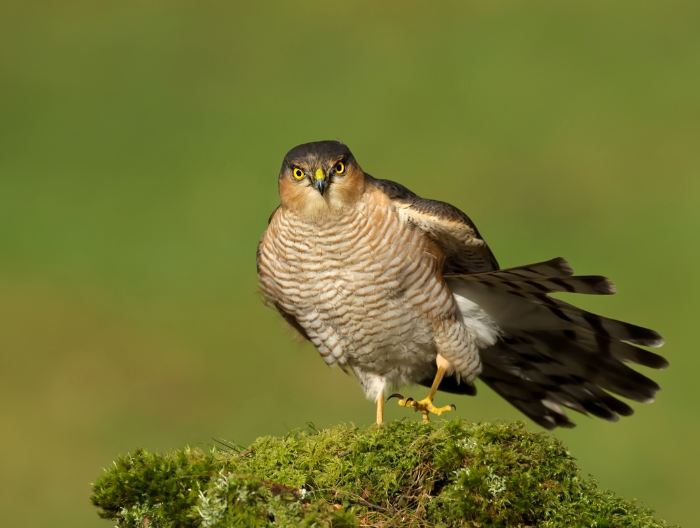
Birds of Prey Habitats and Behaviour
In Cornwall, the habitats and behaviour of birds of prey are as varied as the species themselves. Coastal cliffs provide nesting sites for Peregrine Falcons, offering vast views for hunting. Dense woodlands are the realm of the Sparrowhawk, where their camouflage and agility are key.
Open countryside and farmlands are favoured by Kestrels and Buzzards, with ample opportunities to hunt small mammals and insects. Each species has adapted uniquely to its environment, from the high-speed hunting dives of falcons to the silent, nocturnal prowling of owls.
What Do They Eat?
The larger birds like the Buzzard and Peregrine Falcon typically hunt small mammals and birds. Smaller birds, like the Sparrowhawk, often prey on smaller birds and insects. The diet of the owl species, including the Short-eared Owl and Barn Owl, primarily consists of small mammals, such as voles and mice. Coastal species, like the Osprey, specialise in catching fish. Each species’ diet is adapted to their hunting skills and the availability of prey in their specific habitat in Cornwall. These adaptations not only showcase the incredible diversity of birds of prey in Cornwall but also underline their importance in maintaining the ecological balance of these habitats.
Best Spot for Birdwatching
Cornwall offers numerous prime locations for birdwatching, each unique in its offerings. The coastal cliffs, such as those near Padstow, are perfect for spotting Peregrine Falcons and Kestrels and estuaries like the Camel Estuary provide fishing opportunities for migratory Osprey in the spring and autumn.
Wooded areas like Cardinham Woods provide a haven for Sparrowhawks and Tawny Hobbies, whilst open countryside and farmlands, for instance around Bodmin Moor, are ideal for observing Buzzards. Each location provides birdwatchers with a unique opportunity to observe these majestic birds in their natural habitats, making Cornwall a birdwatching paradise.
Besides the cliffs and countryside, boat trips along the coast can offer unique opportunities to observe birds of prey. These excursions provide a different perspective for spotting various species, with sightings from our trips including Kestrels, Peregrine Falcons, Short-eared Owls and Osprey. Such trips can take you close to their natural habitats without disturbing them, enhancing your birdwatching experience with the added beauty of Cornwall’s scenic coastline.
Conservation Efforts
Conservation efforts in Cornwall are crucial for protecting its diverse bird of prey population. These include habitat management to ensure suitable breeding and hunting grounds, and monitoring programs to track species populations and health.
Education and awareness campaigns help to increase public understanding and support. There are also specific initiatives to protect endangered species and to tackle threats such as habitat loss and pollution. Collaborative efforts between conservation groups, local communities, and authorities are key to the success of these initiatives.
Summary
Cornwall’s diverse habitats offer a splendid array of birds of prey, each with unique behaviours and adaptations. From the cliffs to the woodlands, each environment provides a unique birdwatching experience. Photography enthusiasts can capture stunning images, following ethical guidelines to ensure minimal disturbance to these magnificent creatures.
For an enhanced birdwatching adventure, consider taking a boat trip along Cornwall’s coast, offering a chance to observe these birds in their natural seaside habitats. This experience not only connects you with nature but also supports local wildlife conservation efforts.
